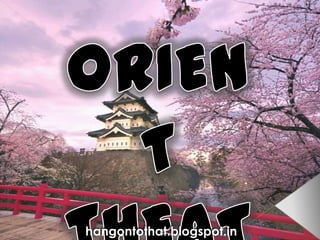
Origins and Development of Traditional Asian Theatre Forms
- 3. •‘Southern’ Drama – Originated around Hangchow •‘Northern’ Drama – Peking (Yuan Period) •Peking Opera – The dominant Theatrical form of China
- 4. Yuan dramatists drew their stories from history, legend, novels, epics and contemporary events. Characters ranged through the entire spectrum of humanity. Although important roles were those of emperors, scholars or students, govt officials, generals, rebels, wives, daughters, or concubines. The plays advocated the virtues of: Loyalty to family and friends Honesty Devotion to work and duty
- 5. Most popular of Yuan dramas is Romance of the Western Chamber by Wang Shih-fu. From the southern Yuan dramas, best known is Lute song, admired by founder of The Ming Dynasty. His patronage increased the prestige of the southern drama and helped to make it the dominant style. Southern drama must be admired for the resiliency that permitted it to survive for some 500 years. Even after 1853, its theatrical traditions and texts were to influence its successor, the Peking Opera.
- 6. Peking Opera was primarily a theatrical rather than a literary form. It emphasized upon acting, dancing, and singing rather than only text. Instead of a single work, an evening’s program is usually made up of a series of short pieces. Many of them were acts or portions of longer works (including traditional southern or northern plays), intermingled with acrobatic displays. There are no intermissions and scenes are arranged to ensure that the best actors are saved for the final episodes.
- 7. Earliest stages were probably porches of temples (influence of temple stage still seen today). Permanent properties on stage – chairs and table. Simplicity allowed rapid change of place. 17th cy – Actors performed in tea houses, while customers were seated at tables. (temporary) Once permanent theatres emerged, they retained this arrangement. The theatre had different sections for different classes. For eg. A balcony divided into sections, in some periods used for the wealthy class and in others it was reserved for women.
- 9. 4 major forms of traditional Japanese theatre: › Noh › Kabuki › Kyogen › Bunraku
- 10. First great Japanese Theatrical form which blossomed in the late 14th Century. First known as sarugaka – no Zeami – Greatest Noh dramatist Culminates in a Dance, and Dialogue and Song preceed to outlined circumstances Actors lines / Narration – Chorus › Ordinary speech used to summarise between parts
- 11. 5 Types: › › › › › Kamimono (Plays praising Gods) Shuramono (Plays about warriors) Kajuramono (Plays about women) Kuruimono (Mad persons or spirits) Kirinomono (Demons, devils or other supernatural beings) No of Roles: Very small, all performers are male Costumes : › Rich in colour and design, based on official dress. Never gaudy › Silk decorated with elaborate embroidery
- 12. Kyōgen - "mad words" or "wild speech” Noh-kyōgen Comical form Elements: › Costumes › Movements › Music
- 13. (Japanese Puppet Theatre) Known as Ningyo Shibai Evolved during 17th century, reached height of popularilty in 18th century. Dolls constantly changing The voice and the music
- 14. Classical Japanese dance-drama Known for › stylization of its drama › elaborate make-up worn by some of its performers History and Transition › Female kabuki › Transition to yarō-kabuki › The Saruwaka-chō kabuki Stage - Hanamichi
- 16. South East Asian theatre is allied to that of India because its heritage of Hinduism, Hindu epics and Buddhism. South East Asian drama consists of folk drama, operetta, spoken drama, pantomime, improvised plays ,shadow puppet play, doll puppet plays and Western-style of drama. The most distinctive form of Asian drama is the Shadow Play which is widely performed in Indonesia, Malaysia and Thailand It is also known as Wayang Kulit in Indonesia. South East Asian theatre is indigenous in nature.
- 17. Between the 13th and 17th centuries the Indonesian and Malaysian shadow puppets involved in their present size. Paintings were usually flat and not in 3-D. The stage is enclosed by flats painted with a distant view. Many scenic pieces were used. Women were allowed to participate in Theatre after the end of Japan’s isolation
- 18. In the 1880s, the western style of drama was introduced in Asia. It reached its peak in 1904 and 1909, and then rapidly declined. An attempt to promote western drama began with the formation of the Free Theatre Society with staged plays by Shakespeare and other famous playwrights. However, despite all trends towards westernization, the traditional forms of Asian theatre such as Noh ( doll theatre) and Kabuki are most popular in Japan and abroad.
- 20. Every oriental country has its own dramatic traditions, often quite diverse and highly developed. Korea’s theatrical forms are related to Chinese and Japanese modes. They had their own distinct characteristics. Ritualistic performances in Korea can be even older.
- 21. Eventually Korea produced various types of dance-drama, puppet shows and after 1908, a western-style drama. One of the most interesting of Korea's theatrical use of many different kind of stories. The variations are numerous indeed.
- 23. All dramas are performed on open stage for the drama play. Music continues all night in the lights of flickering tourches a)Puppet (Muslims) b)traditional dance (temple dancers)15th century
- 24. Bharatnatyam
- 25. Chau
- 26. Kathakali
- 27. Kathak
